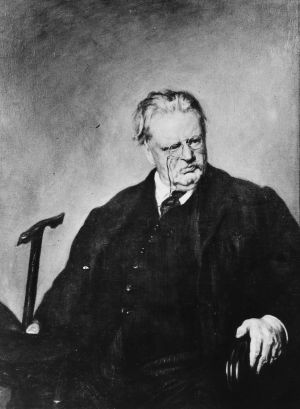MUNDELEIN, Ill. (CNS) — Whether a sainthood cause will be opened for G.K. Chesterton is uncertain, but for a Catholic priest investigating the life of the much-beloved British journalist, philosopher and humorist, the effort already has been a memorable journey.
A year ago, it was announced such an investigation would be opened, Father John Udris was charged with conducting it by his bishop, Bishop Peter Doyle of Northampton, England.
Currently spiritual director of St. Mary’s Seminary in Oscott, England, the priest is the previous pastor of Chesterton’s parish, St. Teresa’s in Beaconsfield.
Chesterton (1874-1936) was an agnostic who converted to Catholicism in 1922 and became one of Catholicism’s best-known defenders.
Father Udris spoke Aug. 1 at the 33rd annual Chesterton Conference at the University of St. Mary of the Lake in Mundelein. The July 31-Aug. 2 gathering was curated by the American Chesterton Society.
In the past year the British priest has been talking to Chesterton scholars, interviewing and reading letters from people who knew Chesterton while he was alive, and pouring over Chesterton’s massive amounts of writings, which range from books to newspaper articles to poems and plays.
One revelation that stands, he told the conference, is the “kinship” he sees between Chesterton and the namesake of his parish, St. Therese of Lisieux, whose “Story of A Soul” autobiography and “little way” of sanctifying the smallest tasks of life for God has made her one of the more popular saints of the past century.
Father Udris said that, so far, he has found just two references to St. Therese in Chesterton’s writings — one allusion after he had made a pilgrimage to Lourdes, France — but he believes they are spiritual brother and sister — “soul twins.”
[hotblock]
He highlighted three virtues Chesterton and St. Therese shared: humility, gratitude and spiritual childhood.
“These were some of the luminous realities that made both of their hearts burn,” he said.
The priest said that, in his research, he has found a popular consensus that Chesterton’s big public persona belied a great humility that grounded him.
He pointed to a statue of Mary holding Jesus that Chesterton gave to his parish. She is portrayed as a peasant dressed in simple clothes and barefoot. Humility to Chesterton in one poem was “the firm feet … that grips the ground like trees,” Father Udris said.
“Both he and Therese, like our Blessed Lady, were blessed with those firm feet,” he said. “Humility is the way we stand and stay grounded in the real world, in God’s world, in the world where all is gift. And therefore it is more wonderful than anything we could have dreamed up for ourselves.”
Father Udris said that whether Chesterton lived a life of heroic virtue — which is part of the examination in a sainthood investigation — is illustrated by “his huge humility.”
It was through that desire for the virtue of humility, he said, that each sought to live life in a constant state of gratitude.
“Gratitude is the distinctive mood that pervades both of their autobiographies,” Father Udris said. “From the first page of ‘Story of A Soul,’ Therese wants to sing the mercies of the Lord, and in (Chesterton’s autobiography), we hear how taking things with gratitude and not taking things for granted was the chief idea of his life.”
With regard to Chesterton’s “spiritual childhood,” Father Udris talked of how, while he was pastor of St. Theresa’s, he got to know a woman named Lucy who in her childhood used to collect mushrooms for the Chestertons. She would drop them off the kitchen door for Chesterton’s wife, Frances.
One time, Father Udris said, Lucy started to skip toward home when Frances called her back.
“She said her husband wanted to meet her. I remember (Lucy) telling me how honored she felt to be issued into the study of this great man and how, as she came through the door, those feelings were turned upside down by the fact that Chesterton got out of his chair in his study far more in awe of her presence entering the room. How telling is that?” Father Udris said.
“Chesterton never wanted to get used to (surprises),” Father Udris continued. “He said, ‘Things grow new as I grow old,’ and that brings to mind for me Therese’s own remarkable ambition — ‘I must stay little and become this more and more.’… There is something in this littleness, this vulnerability that caused both their hearts to burn. And that something is actually the nature of our God.”
St. Therese was born in 1873, a year earlier than Chesterton, but she died in 1897. Chesterton died in 1936.
Father Udris said he does not know if Chesterton ever read St. Therese’s autobiography, but “did he at last recognize her spiritual kinship? I do believe so.”
***
Howard, who attended the Chesterton conference, is editor of The Colorado Catholic Herald, newspaper of the Diocese of Colorado Springs.
PREVIOUS: Amid Iraqi suffering, Chaldean Catholics urged to keep focus on Jesus
NEXT: Across U.S. groups focus on legal needs of unaccompanied minor migrants




Share this story